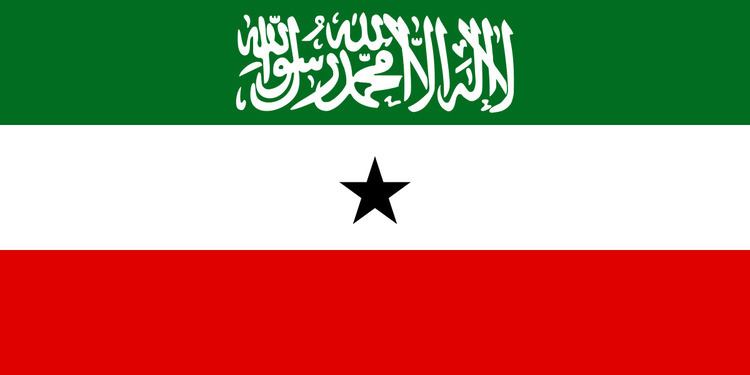 | ||
Over the course of the Somali Civil War, there have been many revolutionary movements and militia groups run by competing rebel leaders which have held de facto control over vast areas of the country.
Contents
- Somali Salvation Democratic Front SSDF
- Somali National Front SNF
- Somali National Movement SNM
- Somali Patriotic Movement SPM
- United Somali Congress USC
- Somali Democratic Movement SDM
- Al Itihaad al Islamiya AIAI
- United Somali Root USR
- Somaliland
- Somali National Alliance SNA
- Somali Democratic Alliance SDA
- United Somali Front USF
- Somali Africans Muke Organization SAMO
- Somali National Democratic Union SNDU
- Somali National Union SNU
- United Somali Party USP
- Factions Present at the 1993 Conference on National Reconciliation in Somalia
- References
Somali Salvation Democratic Front (SSDF)
First Somali resistance group.
Took part in a 1982 Ethiopian border offensive against Somalia.
The SSDF tried to ally with the SNM in 1983, but they failed to agree to a common strategy.
Somali National Front (SNF)
The SNF was a political revolutionary movement and armed militia in Somalia. Initially made up of loyalists to former President of Somalia Siad Barre and the remnants of the Somali National Army forces after his ouster from office, the SNF's intent and goal was to recapture Mogadishu and reinstate Barre's regime. Later, under General Omar Hagi Masallah, the SNF united the Marehan with the other Darod clans led by General Mohammed Said Hersi "Morgan", and then attempted to conquer the region around Kismayo to form the autonomous district of Jubaland.
Somali National Movement (SNM)
Isaaq tribe members had founded the movement in 1981 as emigres to London with the express purpose of overthrowing the Barre regime. They eventually moved to Addis Ababa, Ethiopia, and gained the support of the Ethiopian government.
On January 2, 1982 operating near Berbera, the group attacked Mandera Prison to free political prisoners while simultaneously raiding Cadaadle armory.
Between 1985 and 1987, the SNM conducted many attacks on government facilities and troops based out of camps in Ethiopia.
By 1988, the SNM moved out of their camps in Ethiopia and began operating in northern Somalia, the area now known as Somaliland. They even temporarily occupied the provincial capitals of Burao and Hargeysa.
They captured government Toyota Land Cruisers turned them into technicals by mounting 12.7 mm and 14.5 mm machineguns, 106 mm recoilless rifles, and BM-21 rocket launchers. They also operated various antiaircraft guns, such as the ZU-23-2.
By 1991, they had taken control of Hargeysa, Berbera, Burao, and Erigavo. On May 18, 1991, they declared the Republic of Somaliland.
Somali Patriotic Movement (SPM)
Begun by a group of disaffected Ogadeni officers.
A key accomplishment was the seizure of Balli-Dogle air base in the days prior to Barre's flight from Mogadishu.
United Somali Congress (USC)
On January 26, 1991, the USC stormed the Presidential palace in Mogadishu, taking control of the capital and forcing Siad Barre into exile.
In November 1991, factionalism between Gen. Aidid and Ali Mahdi Mahammad caused a split in the USC. Mohamed Qanyare Afrah was chosen to be the Chairman of the smaller, breakaway "USC Madhi" faction. This leadership position was not recognized by Gen. Aidid.
Somali Democratic Movement (SDM)
Al-Itihaad al-Islamiya (AIAI)
United Somali Root (USR)
Somaliland
The Isaaq-dominated northern Somaliland region of Somalia declared its independence in 1991, but has not been recognized by any country or international organization as a sovereign nation.
Somali National Alliance (SNA)
Its constituents included Mohamed Aidid's breakaway United Somali Congress faction, the Somali Patriotic Movement, Southern Somali National Movement, and other southern factions. His son, Hussein Aidid, assumed leadership upon his death. The SNA became the core of the SRRC in 2001.
Somali National Front (SNF)
Loyalists to Siad Barre, the remnants of his army forces founded the SNF militia after his ouster from office.
Their intent and goal was to recapture Mogadishu and reinstate the regime of Siad Barre, and to establish regional state in Gedo, Middle and Lower Jubba.
Somali Democratic Alliance (SDA)
Pro-Barre faction. Fought against other liberation movements during Barre's reign. Reconciled in 1991 with the SNM to form the Republic of Somaliland. Thereafter, sought the independence of Somaliland from the rest of Somalia.
United Somali Front (USF)
The original USF joined with the SNM in the creation of the Republic of Somaliland.
The Issa clan is a Somali clan that spreads across northwest Somaliland and the nation of Djibouti. The "new" USF especially sought to represent the interests of the Djibouti-based Iise.
Somali Africans Muke Organization (SAMO)
(also called Somali Asal Muki Organization)
Some of the tribes living the jubba and shabelle river banks
Somali National Democratic Union (SNDU)
Somali National Union (SNU)
A political party that was active in the 1960s but was forced into dissolution during the Barre regime. It revived after his downfall.
United Somali Party (USP)
The "new" USP had no affiliation to the original group founded in the 1950s. The new group that bore their name were generally pro-Siad, but key participants in the Reconciliation Conference of the Elders of the Republic of Somaliland at Borama in early 1993.
Factions Present at the 1993 Conference on National Reconciliation in Somalia
The 1993 Informal Preparatory Meeting on National Reconciliation and the Conference on National Reconciliation in Somalia saw the presence of no less than 15 separate factions, including the offshoot SNA branches of USC and SPM. It was a plethora of acronyms: SAMO, SDA, SDM, SNA, SNDU, SNF, SNU, SPM, SPM-(SNA), SSDF, SSNM-(SNA), USC-(SNA), USC, USF, USP. Aidid's four SNA-aligned factions comprised a powerful bloc.
The progressive tone of the proceedings was undercut by the actual lack of progress in the regions and on the streets of Mogadishu. In time, new factions emerged as the Somali Civil War entered a new phase: disintegration into independent and autonomous states.
